In celebration of the upcoming release of George Miller’s Furiosa: A Mad Max Saga, here are my quick thoughts on Mad Max: Fury Road and how the film deepened my understanding of the constellation Pegasus and vice versa.
Pegasus as the Witch’s Fetch
In some expressions of Old Craft, an animal spirit, its powers and specific wisdoms, is magically bound to the sorcerer in the form of the Fetch, the bestial double, or divine theriomorph, who goes for
Daniel Schulke, Viridarium Umbris
th in shade by night for the stalking and harvesting of knowledge, one aspect of the Wild Hunt.
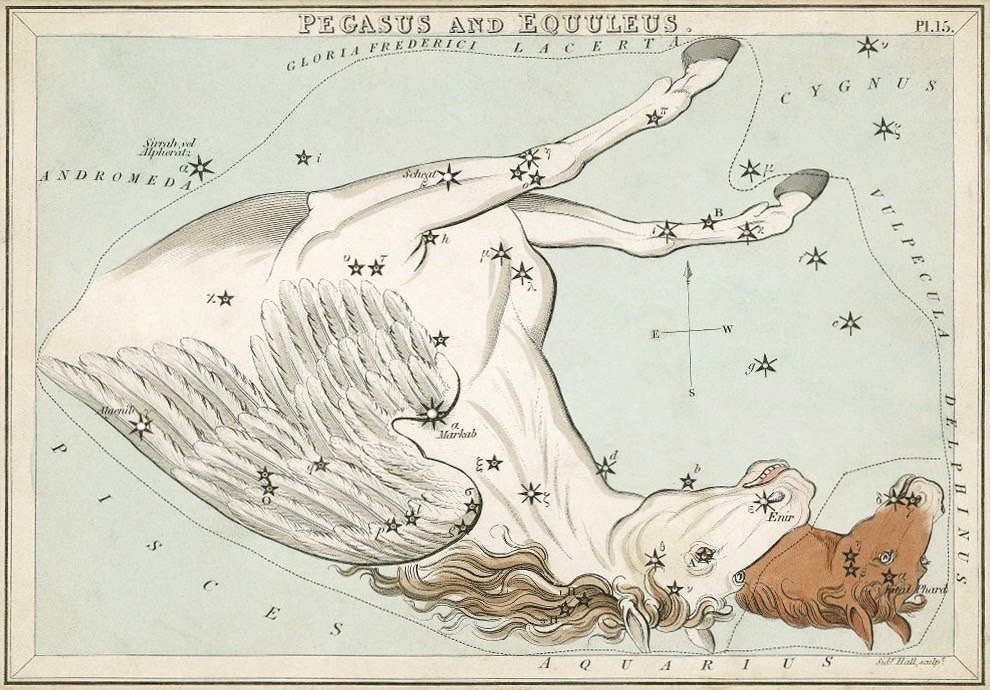
While the fixed star Mirach is one I have a rising paran with, the fixed star Alpheratz is one that I have a culminating sun paran with. Alpheratz’s name was derived from the Arabic Al Surrat al Faras, the navel of the horse. Before astrologers chose to categorize Alpheratz as a star of Andromeda’s head, Alpheratz was a part of the Pegasus constellation. Such a debate on which constellation Alpheratz belongs to is not uncommon, for different cultures often interpret different stars and constellations in their own ways.
But what if this is no accident?
What if Alpheratz is both Pegasus and Andromeda?
The ancient Celts believed that the soul resides not in the heart, but in the head. This is true for various Vedic myths as well, as the head — often referred to in metaphorical expressions such as the ‘head of the universe’, the ‘head of the bull’ or the ‘head of the cow’ — is suggested to indicate the invisible and mysterious place where a treasure or secret is hidden, where the essence of the universe is hidden. There is something which dwells in the head which is sacred and powerful.
It’s only after reading something Sasha Ravitch has written that it clicked. In Sasha’s interpretation, Andromeda’s tale could be interpreted as that of an initiation, with Cetus being the monster who makes Andromeda into a witch. Although Andromeda was forced into her circumstances by the action of her parents, it is through the choice to allow herself to be sacrificed to Cetus — the powers of radical passivity, no different than the Hanged Man submitting himself to be hung or Odin willingly hanging himself upon Yggdrasil — that Andromeda finds her agency. Andromeda approaches Cetus not as a prey before a predator, but as a self-sacrificial priestess laying upon an altar, awaiting the coming of a god. As Sasha has theorized, Perseus’ ‘rescue’ of Andromeda is not so much a rescue but an interruption of her initiation into her witch-body— that being Pegasus.
In other words, to quote Sasha: “Pegasus is the fairysteed, the fairy horse […] who Andromeda escapes upon”.
If Andromeda is a witch then Pegasus is her fetch.
Pegasus is the witch-beast who allows Andromeda to fly, enabling her soul and spirit to take flight. It is for this reason that I believe the fixed star Alpheratz represents this part of Pegasus that is connected to Andromeda.
Furthermore, back in February of this year, astrologer and friend Maeg Keane had written for me an experimental ‘Planetary Telegraph’, more information on that can be found here. I had allowed Maeg to pick whatever planet in my chart they felt called towards, and to the surprise of us both, Mercury came through— more than that, it was Andromeda and Pegasus who spoke through the mouth of Mercury. I wish to share an excerpt of the telegraph here:
“Andromeda walks ahead. Behind her is her horse-body, her mare-body, her mer-body. She lifted herself out of it with much effort and grief. She did not want to go on without it and yet, this is a place of sacrifices. There it is, glitching between grey hoof and pale rainbow coruscating fin. It is of the sea but made of heat, and all around it pyrophytic plants already have begun to bloom, a tomb of plants with red stems and veins, with red sap like jelly, as well as larch and buckthorn, eucalyptus, and small blooms of purple and yellow. It is her heart lying there, this creature — a smoking thing, a clearing thing. This was the vehicle to get her where she’s going, but it had to be sacrificed.”
Here is Andromeda before the whole debacle of how she is to be chained to the rocks and sacrificed to Cetus. Here is Andromeda sacrificing Pegasus to her grief, as Maeg has explained, “to step out of her body and leave it behind, only to be ‘saved’ by it later”. Pegasus is a steed, a vehicle, a vessel of flight and transportation for the soul as much as for the body, and be letting it go — by letting it undergo the transmutation of a spiritual death — the steed is able to come back to grant her flight in the moment that she needed it to.
[If you want to learn more about Pegasus, I highly recommend you read Maeg’s writing on Pegasus, a newsletter piece titled ‘horsefeathers: rejecting the premise’. ]
On Cars and Chimeras
[…] the kind of vehicles we have now, which rely so much on computers, really wouldn’t survive in a post-apocalyptic world. But the hot rods and muscle cars not only survive, they become almost fetishized, like religious artifacts.
George Miller, director of Mad Max in an interview
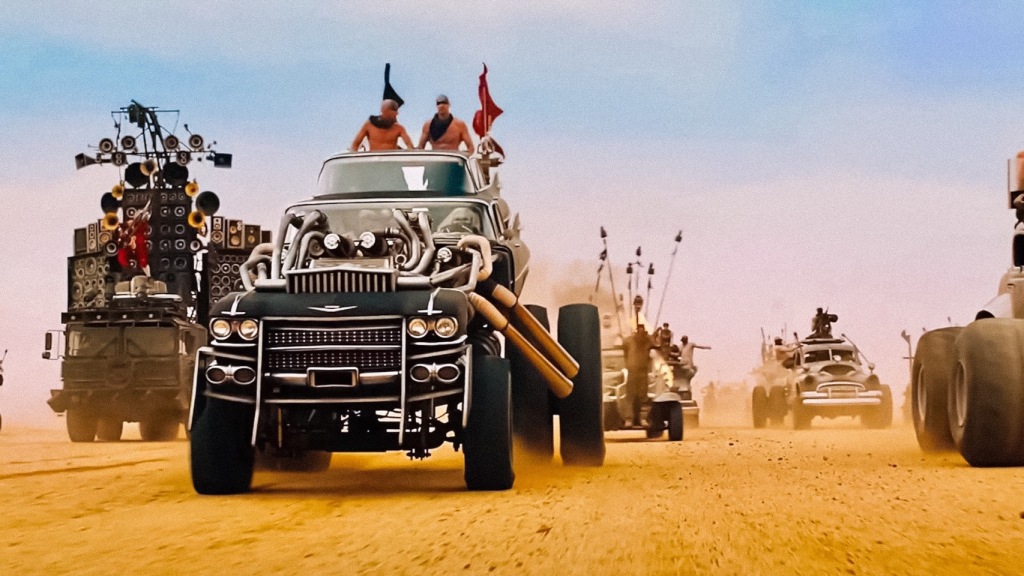
Pegasus has been on my mind lately. Something else that has been on my mind lately too is the movie Mad Max: Fury Road of which I completely adore and am obsessed with. I have a hobby where I will sometimes try to identify stellar motifs within the movies I watch, the stories I read or the games I play. It’s just a fun thing, really. One star that came up for this film, however, utterly flabbergasted me.
You guessed it: Pegasus.
But it makes perfect sense.
Mad Max is a series famous for its automobile stunts. Fury Road especially takes this a step further: there is an entirely post-apocalyptic cult of people who worship cars. The cult of the V8 engine. It’s not so insane why cars would end up being revered. It is nigh impossible to navigate the scorching wasteland by foot without dying from dehydration or a heat stroke. Cars, therefore, are saviors of men, allowing mankind to travel, for supply chains which form the backbone of civilization (or what’s left of civilization) to exist. Without cars, travel is impossible and without travel, one cannot build a thriving settlement.
The Fury Road video game takes this even further. Max is dubbed to be the Warrior Saint of the Magnum Opus, the Angel Combustion— the ultimate car whose body is made from a 1973 Ford XB Falcon by the name of the ‘Wild Hunt’, among various other mechanical parts. Death and machinery and transcendence also comes up as a theme, for there are those “on a path of the spirit” who seek to win a highly difficult road race called the “Death Run” in order to “bind their beings to their machines”. In other words, it is a tale of the witch or shaman becoming one with their fetch, or a believer joining their being with their god.
When you think about it, the first ‘cars’ of mankind were horses. This is, I believe, why engines are measured in horsepower.
Immortan Joe, the villain of the film, adorns himself with horse imagery for this very reason. His mask is decorated with horse teeth. Horses are symbols of power, of virility, of strength and endurance. His personal vehicle, the flagship of his armada, is named the Gigahorse. But, it — like many other cars in the film — is no true horse though.
It is a chimera, a holy monstrosity.
A chimera is an aberrant thing, an amalgamation of various beasts or beings. The Gigahorse is not a single car, but an amalgamation of two 1959 coupe DeVilles bound together like a mutated conjoined twin (interviews with the designers stated that they wanted to make it look like two cars humping each other— again, a call back to the virility of the horse-beast). It has two V8 engines locked together into one shaft, plus a myriad of other additions such as a harpoon gun and a flamethrower— things which do not belong in a conventional car.
The Gigahorse, even for a car, is unnatural.
Still, one could argue perhaps that all cars are unnatural, in the same manner that all machinery is unnatural as they are made by man or something Other— that they are not born from the natural world. Yet, is the oil that flows through a car’s engine not akin to the blood that pumps through our heart, circulating and animating our body? Are fuel tanks not akin to stomachs? Does a car exhaust system not expel waste and carbon dioxide much like our respiratory system does? Do cars not break down with age and require maintenance, much like all living beings do?
In a way, are cars not alive?
In the world of Mad Max, cars are just as alive as we are, just as alive as horses are.
Pegasus too is a chimera, a being not entirely mare nor bird, born from the violence of decapitation, whose mother is a monster. Pegasus too is a vehicle, a vessel for the witch, for the heroes and the courier of the lightning of the gods.
The War Rig is another car that, in the words of the creators of the film, is very much its own character. It is treated by the editors of the movie as if it is alive. The designer described it as a ‘meandering beast’. The sound editing for the chase in which Immortan Joe goes after Furiosa who rides the War Rig was inspired by Captain Ahab’s pursuit of Moby Dick. Mark Mangini, the sound editor for the film, has stated that: “We wanted to give the sense that the war rig was living. We used whale vocalizations as part of the kit of sound. When a harpoon hits the rig, you hear whale groans. For the death of the war rig, we used sounds of dying animals, including bears and whales, slowed down to have a real-world emotional response.”
In other words, the War Rig too is a chimera of whales and bears and automobile machine-metal. The War Rig too is a Pegasus.
I could go into more and more vehicles in the film and how they are linked to Pegasus, but it is safe to say that the point has been made.
This movie is filled with Pegasi.
The Lightning Storm: A Symbol of Rebirth
[…] the Swift, the Lightning-Bolt, in whom is the sudden touch of Creation and Destruction
Andrew Chumbley, Azoëtia: A Grimoire of the Sabbatic Craft
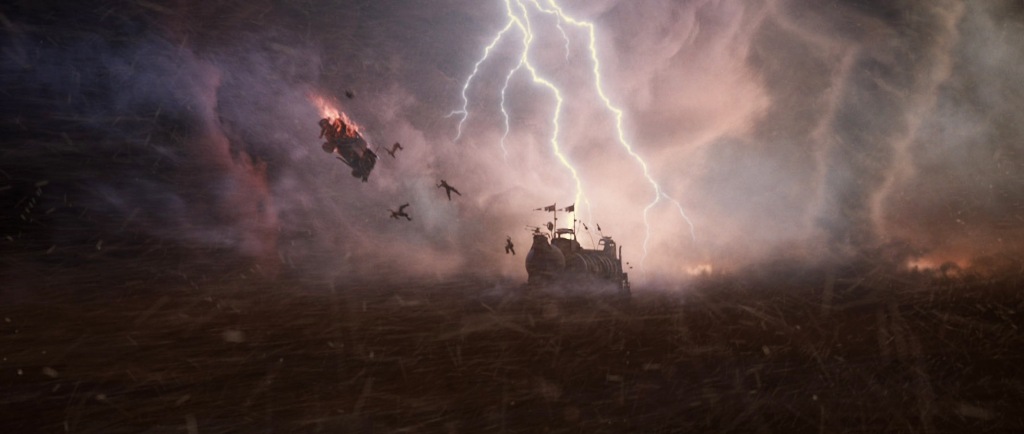
Pegasus, in Greek Mythology, is the bearer of Zeus’ lightning. Many who are deities of storms and lightning are also fertility gods. Zeus himself is also known as Zeus Georgos, presiding over crops and farmlands and farmers. Lightning, after all, makes the land fertile. Lightning sunders apart airborne nitrogen molecules and turns them into nitrates which then gets carried down to earth by rainfall, enriching the land and the plants with the much needed nutrient. Lightning, although associated with destruction and divine judgment, is also associated with life. Pegasus, the bearer of lightning, can thus be considered to be the bearer of life and, as I wish to argue, the bearer of new life— of spiritual renewal and rebirth. There is a reason why the Tower card in Tarot, representing change and upheavals, depicts a lightning-struck tower.
As explored by Chi-Ying Yu in her paper The Appearance and Resonance of Apocalyptic Archetypes in Contemporary Disaster Films, the occurrence of storms in literary works — such as King Lear, Wuthering Heights, and The Wonderful Wizard of Oz — often acts as a symbol to represent the characters’ emotional turmoil. After the storm has passed, the characters emerge as changed somehow. A dying of the old self and the growth of a new one. The symbol of storms as a herald of personal change — specifically of sandstorms — is also true in Kafka on the Shore by Haruki Murakami. Below is a quote from the aforementioned novel, which to me really encapsulates the nature of storms as the force which forces you to change, to bleed, to grow, and be reborn:
Sometimes fate is like a small sandstorm that keeps changing directions. You change direction but the sandstorm chases you. You turn again, but the storm adjusts. Over and over you play this out, like some ominous dance with death just before dawn. Why? Because this storm isn’t something that blew in from far away, something that has nothing to do with you. This storm is you. Something inside of you. So all you can do is give in to it, step right inside the storm, closing your eyes and plugging up your ears so the sand doesn’t get in, and walk through it, step by step. There’s no sun there, no moon, no direction, no sense of time. Just fine white sand swirling up into the sky like pulverized bones. That’s the kind of sandstorm you need to imagine.
And you really will have to make it through that violent, metaphysical, symbolic storm. No matter how metaphysical or symbolic it might be, make no mistake about it: it will cut through flesh like a thousand razor blades. People will bleed there, and you will bleed too. Hot, red blood. You’ll catch that blood in your hands, your own blood and the blood of others.
And once the storm is over you won’t remember how you made it through, how you managed to survive. You won’t even be sure, in fact, whether the storm is really over. But one thing is certain. When you come out of the storm you won’t be the same person who walked in. That’s what this storm’s all about.
In Mad Max: Fury Road, a scene that took my breath away and left me astonished was the scene where the characters drive into a sandstorm. A cloud of red and brown dirt whirls about them, as lightning strikes and thunder roars all around, many of the vehicles bursting aflame when struck by the furious lightning. The rising adrenaline and tension and the flashing colors — almost psychedelic in its intensity, which makes sense considering we are viewing the scene from Nux’s perspective and Nux is high from huffing paint — all combine to form an unforgettable theatrical moment. What truly added to the visuals, making the moment akin to a transcendent spiritual experience, was the sweeping orchestral score.
During this awe-inducing sand-and-lightning storm scene, we hear the background music playing, the OST ominously titled ‘Storm is Coming’. Here, for what I believe is the first time, we hear the motif associated with Nux’s death and rebirth (and his many attempts of reaching Valhalla). The first time we hear it is during the sandstorm. The second time is when he tries to jump onto the War Rig to bring back the wives — to please his God, the Immortan Joe, so he can secure his place in Valhalla — and fails hilariously. The final time is when he finally successfully sacrifices himself. This time, he did it for his friends and his loved ones. He did it for the hope of his death bringing about a better world for all. Throughout these attempts, one phrase gets repeated several times by Nux: “I live, I die, I live again”.
I just want to make it clear though that I am not necessarily intending to draw a parallel between Nux and Andromeda, but merely to point out the lightning-storm-Pegasian role as the being which facilitates a person’s spiritual death and rebirth. Likewise, Pegasus isn’t the only star I associate with storms and lightning. Capella too is a storm goddess. Castor too is the one who guides sailors through storms. Yet, it cannot be understated that Pegasus — the bearer of lightning — is as much the deliverer of all the powers associated with lightning as well.
Alpheratz, On Wings of Hope and Freedom
I am no bird; and no net ensnares me; I am a free human being, with an independent will.
Charlotte BrontË, Jane Eyre
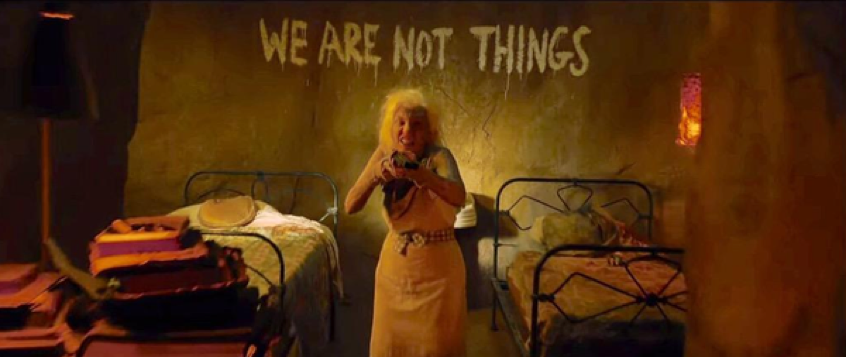
Alpheratz, the star of Pegasus and Andromeda, is a star of freedom. Bernadette Brady states that Alpheratz is “linked to freedom, love of movement, speed, and the sheer joy of the wind in one’s hair.” Movement and speed certainly links to the whole fast-moving vehicle chase and race that forms the crux of the movie. Freedom too is a theme that comes up again and again in the film. Furiosa, along with the wives, are enslaved by Immortan Joe and wishes to free themselves. Nux, and the other warboys, are arguably bound to Immortan Joe by ways of being inducted into the Immortan’s death cult. Nux too seeks freedom — ‘hope’, as he would claim at the end, that the idea of liberating the Citadel ‘feels like hope’ — even if it takes him the course of the film to realize it.
Some of the famous lines that emerge from the movie includes a line from Miss Giddy wherein she screams to Immortan Joe that “you cannot own a human being! Sooner or later, someone pushes back!” One of the wives also had a moment where, in grief and pain, she feels the urge to return to her abuser and beg for his forgiveness, believing if momentarily that it is foolish to escape. Here, the other wives —her friends — remind her that “we are not things”, not objects to be owned and enslaved, that “wring your hands, tear your hair, but you’re not going back. You’re not going back to him!”
The idea of freedom comes with the idea of choice. Nux gains his freedom by choosing to die, not for his once revered Immortan Joe’s sake, but as a sacrifice for his newfound friends and love. Max gets the choice of choosing to aid Furiosa or abandon her, to remain an animal or reclaim his humanity. Furiosa gets the choice of whether she wishes to take a journey into the unknown in hopes of reaching the other side of the Salt Plains, or to return to the Citadel and retake it and create a better home for herself and others there. In the end, the choice of whether to move forward or backward or elsewhere is the choice the Pegasus provides to Andromeda and Perseus and others who would ride him.
Conclusion and Final Thoughts
Pegasus is more than a whimsical winged horse, not that there is anything wrong with being a whimsical winged horse. He is a chimera: a beast, a divine monster, something Other. He is the deliverer of destruction and renewal. He is the fetch which enables the witch to be reborn and to take flight.
I would like to end this blog post with a poem by Eleanor Farjeon titled ‘Pegasus’.
From the blood of Medusa
Pegasus sprang.
His hoof of heaven
Like melody rang.
His whinny was sweeter
Than Orpheus’ lyre.
The wing on his shoulder
Was brighter than fire.
His tail was a fountain.
His nostrils were caves.
His mane and his forelock
Were musical waves.
He neighed like a trumpet.
He cooed like a dove.
He was stronger than terror
And swifter than love.He could not be captured.
He could not be bought.
His rhythm was running,
His standing was thought.
With one eye on sorrow
And one eye on mirth,
He galloped in heaven
And gamboled on earth.
And only the poet
With wings to his brain
Can mount him and ride him
Without any reins.
The stallion of heaven.
The steed of the skies.
The horse of the singer,
Who sings as he flies.
References
- https://www.patreon.com/sasharavitch/posts
- https://www.third-sister.com/telegraph
- https://www.mdpi.com/2077-1444/12/11/913
- https://fourstringfarm.com/2014/05/27/why-farmers-love-lightning/
- The Art of Mad Max: Fury Road by Abbie Bernstein
- Kafka on the Shore by Haruki Murakami
- Lightning: Nature and Culture by Derek M. Elsom
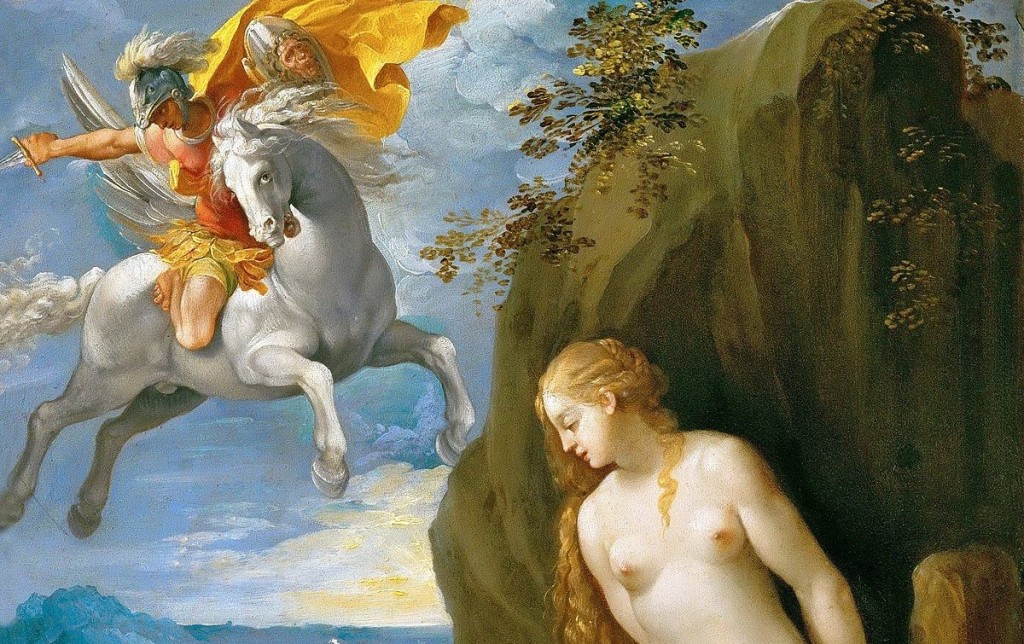
3 responses to “Pegasus in the Post-Apocalypse: Interpreting Mad Max: Fury Road through the Lens of Fixed Stars”
This is so interesting, thank you. But can I ask you (if you feel you can) to elaborate on Capella’s association with storms? It’s not part of any star lore/mythology I’m familiar with but there’s a lot out there so I might have missed something, unless it’s a personal gnosis of yours?
Thanks!
LikeLike
Capella is associated with Amalthea, the she-goat nurse of Zeus who nourished him with milk in a cave. This makes Capella, in some ways, the mother-nurse of Zeus, the exalter of the god of lightning and storms. In classical times Capella was also noted for its association with floods and storms. Pliny referred to its as ‘the Rainy Goat-starre’ whilst Aratus spoke of how the goat often saw men ‘storm-tossed’ at sea. Hope this helps!
LikeLike
Makes sense re: the Zeus connection, thanks for pointing this out. Thank you!
LikeLike